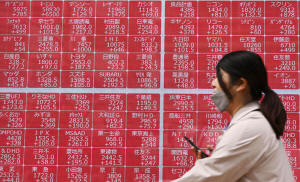Global shares jump following historic gains on Wall St after Trump
paused most of his tariffs
[April 10, 2025] By
YURI KAGEYAMA
TOKYO (AP) — World markets soared on Thursday, with Japan’s benchmark
jumping more than 9% as investors welcomed U.S. President Donald Trump’s
decision to put his latest tariff hikes on hold for 90 days, though he
excluded China from the reprieve.
In early trading, Germany’s DAX initially gained more than 8%. By
midmorning, they were up 5.3% at 20,720.86, while France's CAC 40 in
Paris gained 5% to 7,204.23. Britain's FTSE 100 surged 4.0% to 7,983.37.
Chinese shares saw more moderate gains, given yet another jump in the
tariffs each side is imposing on each others’ exports.
The future for the S&P 500 was down 2.1% while the contract for the Dow
Jones Industrial Average dropped 1.6%.
Analysts had expected the global comeback given that U.S. stocks had one
of their best days in history on Wednesday as investors registered their
relief over Trump’s decision.
“Everything is still very volatile, because with Donald Trump, you don’t
know what to expect. This is really big uncertainty in the market. The
threat of recession has not faded," said Francis Lun, chief executive of
Geo Securities.
In Asia, Japan’s benchmark Nikkei 225 jumped 9.1% to finish at
34,609.00, zooming upward as soon as trading began.

Australia’s S&P/ASX 200 soared 4.5% to 7,709.60. South Korea’s Kospi
gained 6.6% to 2,445.06. Hong Kong's Hang Seng added 2.1% to 20,681.78.
The Shanghai Composite rose 1.2% to 3,223.64.
Investors went “from fear to euphoria,” Stephen Innes, managing partner
at SPI Asset Management, said in a commentary.
“It’s now a manageable risk, especially as global recession tail bets
get unwound, and most of Asia’s exporters breathe a massive sigh of
relief,” he said, referring to the tariffs on China, which Trump has
kept.
On Wednesday, the S&P 500 surged 9.5%, an amount that would count as a
good year for the market and its third-best day since 1940.
The Dow Jones Industrial Average shot to a gain of 2,962 points, or
7.9%. The Nasdaq composite leaped 12.2%.
Markets had been sinking earlier in the day on worries that Trump’s
trade war could drag the global economy into a recession. But then came
the posting on social media that investors worldwide had been waiting
and wishing for.

[to top of second column] |

A person walks past an electronic stock board at a securities firm
in Tokyo Thursday, April 10, 2025. (Kyodo News via AP)
 “I have authorized a 90 day PAUSE,”
Trump said, saying more than 75 countries are negotiating on trade
and not retaliating against his latest increases in tariffs. China
was a huge exception, with Trump saying tariffs are going up to 125%
against its products.
Treasury Secretary Scott Bessent later told reporters that Trump was
pausing his so-called ‘reciprocal’ tariffs, announced on his April 2
“Liberation Day,” on dozens of trading partners. He kept a 10%
tariff on nearly all global imports.
China was a huge exception, though, with Trump saying tariffs are
going up to 125% against its products, after Beijing hiked its
tariffs on U.S. exports to 84%.
The trade war is not over, and an escalating battle between the
world’s two largest economies can create plenty of damage. U.S.
stocks are also still below where they were just a week ago.
Wall Street also got a boost from a relatively smooth auction of
U.S. Treasurys on Wednesday. Earlier jumps in Treasury yields had
indicated increasing levels of stress and Trump said he had been
watching the bond market “getting a little queasy.”
Higher yields on Treasurys put pressure on the stock market and push
upward on rates for mortgages and other loans for U.S. households
and businesses. U.S. Treasury yields have historically dropped — not
risen — during volatile times because the bonds are usually seen as
some of the safest possible investments.

This week’s sharp rise had brought the yield on the 10-year Treasury
back to where it was in late February.
After approaching 4.50% in the morning, the 10-year yield pulled
back to 4.34% following Trump’s pause and the Treasury’s auction.
By early Thursday, it was trading at 4.28%, up from 4.26% late
Tuesday and from just 4.01% late last week.
In energy trading, benchmark U.S. crude fell $1.62 to $60.73 a
barrel. Brent crude, the international standard, declined $1.67 to
$63.81 a barrel.
In currency trading, the U.S. dollar fell to 146.06 Japanese yen
from 147.77 yen. The euro cost $1.1052, up from $1.0951.
All contents © copyright 2025 Associated Press. All rights reserved |